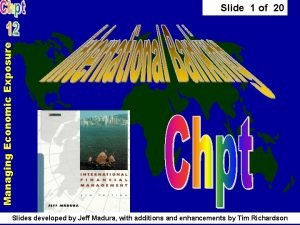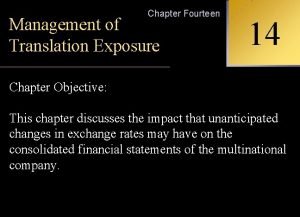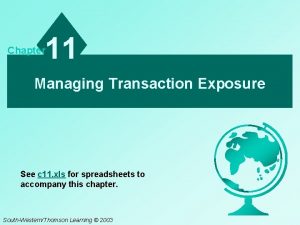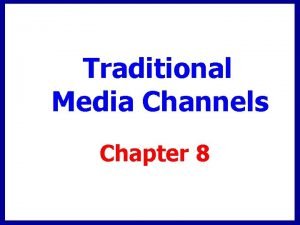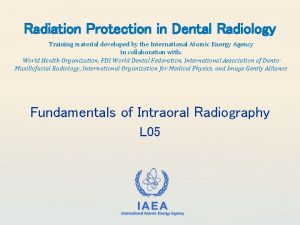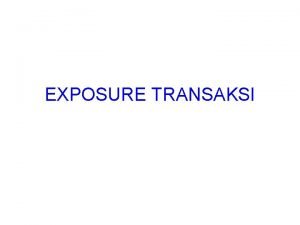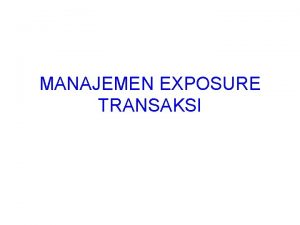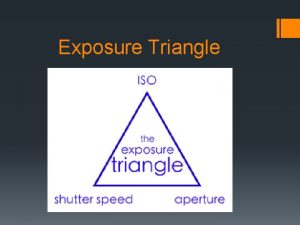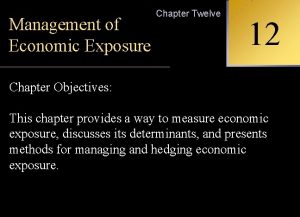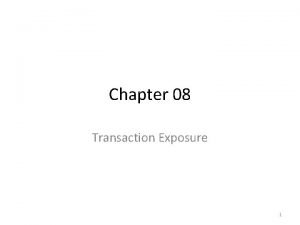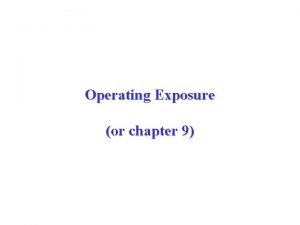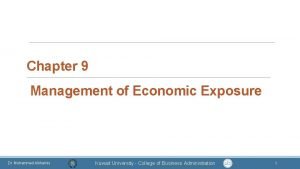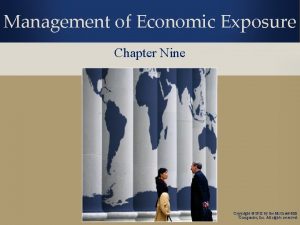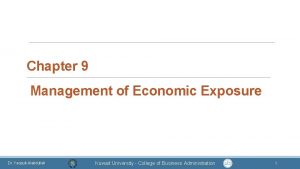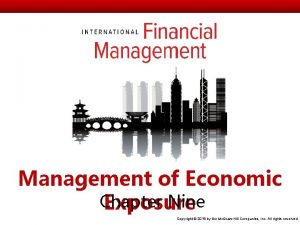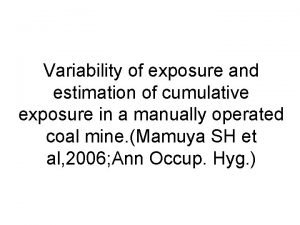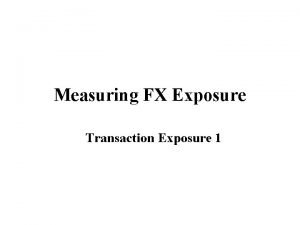Chapter 9 Management of Economic Exposure What is































- Slides: 31

Chapter 9 Management of Economic Exposure

What is economic exposure? The possibility that a firm’s cash flows and overall value may be affected by unexpected changes in foreign exchange rates Affects purely domestic firms and firms involved in international markets Also called operating exposure

Example Consider a purely domestic U. S. bicycle manufacturer Sources all materials domestically Sells exclusively in the U. S. market with no foreign receivables or payables No direct involvement in international markets This U. S. manufacturer has a Taiwanese competitor that exports to the U. S. If the Taiwanese dollar depreciates against the U. S. dollar, the U. S. dollar price of the Taiwanese bicycles will decrease, boosting the imported bicycle’s sales

Another Example Consider Laker Airways, a bankrupted private British low-fare air carrier Laker Airways borrowed heavily in U. S. dollars to finance acquisitions of aircraft, but generated more than half of its revenue in British pounds As the dollar appreciated against the pound throughout the early-mid 1980 s, Laker could no longer cover its dollar denominated debt with its revenue, causing it to default Laker consequently went bankrupt on 5 February 1982

Measuring Economic Exposure Economic exposure is the sensitivity of a firm’s operating cash flow and overall value to unexpected changes in exchange rates This sensitivity can be measured using statistics are we supposed to include statistics?

Determinants of Economic Exposure A firm’s operating exposure is determined by its ability to adjust markets, product mix and sourcing in response to exchange rate changes Difficult to ascertain, unlike transaction exposure

Managing Economic Exposure Selecting low cost production sites Flexible sourcing policy Diversification of the market Product differentiation and R&D efforts Financial hedging

Selecting Low Cost Production Sites Diversify production facility locations to mitigate the effect of exchange rate movements Automobile manufacturers have production facilities in many countries and can choose where to produce given prevailing exchange rates

Flexible Sourcing Policy Source from areas where input costs are low Japan Airlines hired foreign crews to remain competitive in international routes in the face of a strong yen

Diversification of the Market Sell in multiple markets to take advantage of economies of scale and diversification of exchange rate risk

Product Differentiation and R&D Efforts Successful R&D allows for: Cost cutting Enhanced productivity Product differentiation Successful product differentiation leads to less elastic demand, which may translate into less exchange rate risk

Financial Hedging Use derivative securities (e. g. currency swaps, futures, forwards, options) to stabilize cash flows in the near term

Other Key Terms Competitive effect - refers to the effect of exchange rate changes on a firm’s competitive position Conversion effect - refers to the fact that the dollar amount converted from a given cash flow from foreign operations will be affected by exchange rate changes

Case: Economic Exposure of Albion Computers PLC Consider Case 3 of Albion Computers PLC. Now, assume that the pound is expected to depreciate to $1. 50/£ 1. 00 from the current level of $1. 60/£ 1. 00. This implies that the pound cost of the imported part, Intel’s microprocessors, is £ 341 ($512/$1. 50). All other variables remain the same. A. Compute the projected annual cash flow in dollars. B. Compute the projected operating gains/losses over the four-year horizon as the discounted present value of change in cash flows, which is due to the pound depreciation, from the benchmark case presented in Exhibit 12. 4. C. What actions, if any, can Albion take to mitigate the projected operating losses due to the pound depreciation?

A. Projected Annual Cash Flow Sales (40, 000 units at £ 1, 080/unit) £ 43, 200, 000 Variable costs (40, 000 units at £ 697/unit) £ 27, 880, 000 Fixed overhead costs 4, 000 Depreciation allowances 1, 000 Net profit before tax £ 10, 320, 000 Income tax (50%) 5, 160, 000 Profit after tax 5, 160, 000 Add back depreciation 1, 000 Operating cash flow in pounds £ 6, 160, 000 Operating cash flow in dollars (£CF x $1. 50) $9, 240, 000

B. Projected Operating Gains/Losses Variables Benchmark Case Current Case Exchange rate ($/£) 1. 60 1. 50 Unit variable cost (£) 650 697 1, 000 1, 080 50, 000 40, 000 Unit sales price (£) Sales volume (units) Annual cash flow (£) 7, 250, 000 6, 160, 000 Annual cash flow ($) 11, 600, 000 9, 240, 000 Four-year present value ($) * 33, 118, 000 26, 380, 000 Operating gains/losses ($) (6, 738, 000)

C. Options to Reduce Economic Exposure Exchange rate fluctuations influence the cost of imported parts, which in turn affects domestic pricing Two strategies: Source imported parts (i. e. the Intel processors) from countries where input costs are low Utilize financial hedging to stabilize Albion’s cash flows e. g. currency options and forward contracts

Chapter 10 Management of Translation Exposure

What is translation exposure? The effect of unexpected changes in foreign exchange rates on a multinational corporation’s consolidated financial statements A MNC is exposed when it translates or converts its foreign operations into its home currency to create consolidated financial statements Also called accounting exposure

Key Terms Functional currency - the currency of the country in which a foreign division or subsidiary conducts most of its business A single foreign division or subsidiary may conduct business in many different countries and local currencies, but it will record those transactions in a single functional currency Reporting currency - the currency in which a MNC prepares its consolidated financial statements Typically the currency of the country in which the parent is located Financial statements recorded in functional currencies by foreign divisions and subsidiaries are translated or converted into a MNC’s reporting currency during the consolidation process

Four Translation Methods Method Balance Sheet Income Statement Current/ noncurrent - Current accounts translated at current rate - Noncurrent accounts translated at historical rate - Most items translated at average rate for the period - Revenue and expense items associated with noncurrent accounts translated at historical rate Monetary/ nonmonetary - Monetary accounts (cash, receivables, payables) translated at current rate - Nonmonetary accounts (fixed assets, stockholder’s equity) translated at rate in effect when account was first established - Most items translated at average rate for the period - Revenue and expense items associated with nonmonetary accounts translated at historical rate Temporal - Monetary accounts (cash, receivables, payables) translated at current rate - Accounts booked at historical cost translated at historical rate (rest translated at current rate) - Most items translated at average rate for the period - Depreciation and COGS translated at historical rate if related balance sheet accounts carried at historical cost Current rate - All accounts (excl. stockholder’s equity) translated at current rate - A plug equity account (cumulative translation adjustment, CTA) is used to balance - All items translated at a weighted average rate for the period

Managing Translation Exposure Translation vs. transaction exposure Hedge translation exposure Translation vs. operating exposure

Translation vs. Transaction Exposure Translation exposure The effect of unexpected changes in foreign exchange rates on a multinational corporation’s consolidated financial statements An accounting issue Transaction exposure The effect of unanticipated changes in foreign exchange rates on a firm’s cash flows A finance issue It is generally not possible to eliminate both translation exposure and transaction exposure

Hedge Translation Exposure Balance sheet hedge Matching foreign assets with liabilities in the equivalent foreign currencies to eliminate translation exposure Derivatives hedge Using derivative products (e. g. forward contracts) to attempt to manage translation exposure

Translation vs. Operating Exposure Recall that operating exposure is the possibility that a firm’s cash flows and overall value may be affected by unexpected changes in foreign exchange rates A local currency depreciation may positively influence cash flows (operating exposure), but result in a paper loss because of unhedged translation exposure Thus, it is important for management to consider operating exposure when attempting to manage translation exposure

Case: Sundance Sporting Goods, Inc.

A. Consolidated Balance Sheet

B. Translation Exposure Report

C. Future Consolidated Balance Sheet

D. Transaction Exposure Report

Sources Eun, C. S. , & Resnick, B. G. (2015). International Financial Management (7 th ed. ). New York, NY: Mc. Graw-Hill Education.
 Managing economic exposure and translation exposure
Managing economic exposure and translation exposure Transaction exposure vs economic exposure
Transaction exposure vs economic exposure Managing economic exposure and translation exposure
Managing economic exposure and translation exposure Eksposur translasi adalah
Eksposur translasi adalah How to measure economic exposure
How to measure economic exposure Measuring and managing operating exposure
Measuring and managing operating exposure Measuring economic exposure
Measuring economic exposure Economic growth vs economic development
Economic growth vs economic development Growth and development conclusion
Growth and development conclusion Chapter 1 lesson 2 our economic choices worksheet answers
Chapter 1 lesson 2 our economic choices worksheet answers Management of translation exposure
Management of translation exposure Management of transaction exposure
Management of transaction exposure Techniques of transaction exposure management
Techniques of transaction exposure management Chapter 17:4 providing first aid for shock
Chapter 17:4 providing first aid for shock 17:6 providing first aid for burns
17:6 providing first aid for burns Social forces behind management thought
Social forces behind management thought Pyramid levels of management
Pyramid levels of management Top management middle management first line management
Top management middle management first line management Basic concepts of management
Basic concepts of management Whmis 2015 stands for
Whmis 2015 stands for Risk exposure index
Risk exposure index Unit 15:8 providing first aid for cold exposure
Unit 15:8 providing first aid for cold exposure Stacy shaw welch
Stacy shaw welch Slut award
Slut award The traditional three-exposure hypothesis is based on:
The traditional three-exposure hypothesis is based on: Nilai ambang batas skd 2021
Nilai ambang batas skd 2021 Two factor theory psychology
Two factor theory psychology Ideally insurable risk
Ideally insurable risk Faulty
Faulty Exposure therapy irvine
Exposure therapy irvine Exposure therapy irvine
Exposure therapy irvine Exposure sheet animation
Exposure sheet animation






